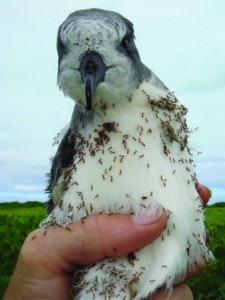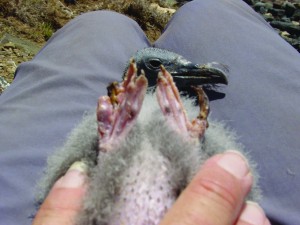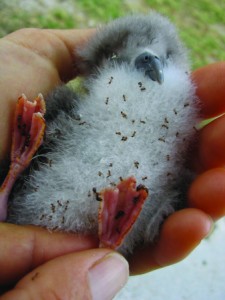The Hawaiian archipelago is crawling with ants and not a single one belongs here. Humans

A petrel is covered by big-headed ants on Kure Atoll. While ants can be a nuisance for people, the insects can maim or kill nesting seabirds.
SHELDON PLENTOVICH photo
introduced over forty-five ant species to the islands. While they’re a nuisance to people, to Hawaiian seabirds they are a major problem.
Sheldon Plentovich is the Coastal Program Coordinator with the Pacific Islands Fish and Wildlife Office. She has studied some of these impacts. “Seabirds nesting in Hawaii do not have effective defenses against dense supercolonies of invasive ant species,” she says. And even though high densities of invasive are present, the seabirds return to the same areas to nest as they have for generations.
In March, throughout Hawai‘i, Wedge-tailed Shearwaters dig burrows for nesting along the coastline. Unfortunately tropical fire ants, Solenopsis geminata, often inhabit these areas. Plentovich isn’t sure whether the ants are trying to eat the birds or if the ants are just defending their nest. Adult birds can fly away to escape the ants but the chicks can’t. “They’re programmed to stay in the nest,” explains Plentovich. In their fury, the six-legged invaders destroy the tender webbing on the chicks’ feet. These ant attacks affect the development of the chicks as well. Oftentimes chicks that have been attacked fail to grow feathers.
Plentovich knocked back the population of tropical fire ant on one islet off the coast of O‘ahu and, as expected, found that the seabirds had greater fledgling success compared to those on an islet still infested by tropical fire ant.

Tropical fire ants attack a wedge tailed shearwater chick on islet off Oahu. These attacks can permanently disfigure birds’ feet and even lead to chick’s death. Photo Sheldon Plentovich
Tropical fire ants belong to a group designated as “tramps.” Tramp ants are omnivorous, and because they do not compete between colonies, form dense supercolonies made up of multiple queens. These dense supercolonies can outcompete everything else for food and resources. And since it takes a queen to start a new colony, the greater density of queens makes it easier for these ants to be spread around by people. Not surprisingly tramp ants include some of the Pacific’s most devastating invasive species, such as the little fire ant. They’ve hitched rides to the furthest reaches of the Hawaiian archipelago.
Johnston Atoll is one of the most isolated atolls in the world, 860 miles west of Hawai‘i. The Atoll is strictly a wildlife refuge where red-tailed tropicbirds nest alongside shearwaters, petrels, terns, noddies, and boobies. Unfortunately the atoll has become a haven for the yellow crazy ant or Anoplolepis gracilipes. This tramp ant doesn’t bite or sting the birds, rather it sprays them with formic acid and birds don’t respond well to formic acid. Animals that can seek out fish from the sky are left with swollen puffy eyes. Plentovich has seen Red-tailed Tropicbirds that have “toughed it out” staying to nest despite being swarmed by ants, spraying formic acid.
Footage of a Red-tailed Tropicbird swarmed by yellow crazy ant on Johnston Atoll. These invasive ants swarm nesting seabirds. Seabirds show high nest fidelity and return to the same location to rear their young despite the presence of these ants. Video by Sheldon Plentovich
Ants impacts can vary from place to place. The big-headed ant, Pheidole megacephala, is one of the most common ants in Hawai‘i. On Moku‘auia off Oahu, eradicating big-headed ant had no effect on the hatching and fledging success of shearwater chicks.

Big-headed ant attacks Bonin Petrel chick on Kure Atoll. Big-headed ants are one of the most common ants in Hawaii but on Kure the population reached such a high density the ants were attacking everything in sight. Photo by Cynthia Vanderlip
But on Kure Atoll the big-headed ant has been seen swarming birds and eating chicks alive. Plentovich thinks ant density is the reason. On Kure, the population of big-headed ants was 5 times more dense than it ever was on Moku‘auia. “They’re eating everything they encounter,” says Plentovich.
Chances are people inadvertently brought ants to isolated Johnston and Kure Atolls. All it takes is a single queen ant in a piece of cargo to start an infestation. And eradicating an established infestation is extremely difficult work. Plentovich is hopeful that new techniques will lead to the eradication of yellow crazy ant on Johnston atoll where other techniques have been unsuccessful. She’s seen how controlling an invasive ant can influence the whole ecosystem. When she reduced the population of invasive ants on offshore islets she saw an increase in the diversity of insects and “native plants survived better-the ‘ilima started taking off.”
By Lissa Fox Strohecker. Originally published in the Maui News, October 14th, 2012 as part of the Kia‘i Moku Column from the Maui Invasive Species Committee.
You can find all the articles in the Kia‘i Moku series http://www.hear.org/misc/mauinews/



Kure Atoll does not have Yellow crazy ants, thank goodness! the ants swarming the tropicbird are Big headed ants. Sheldon is not likely to have make this mistake as she has been instrumental in our eradication of Bigheaded ants and has conducted ant serves on Kure her self. Please correct the information ASAP.
thanks! and keep up0 the good work
Cynthia Vanderlip
Kure Atoll Biological Field Station Supervisor
Thanks for the correction Cynthia – fixed!
Done – thank you for letting us know.